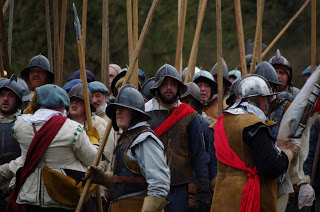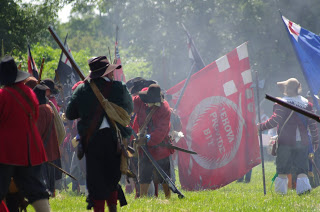Lord Fairfax’s Lifeguard of Horse
The final Parliamentarian harquebusiers for some time leave the painting table.

Lord Ferdinando Fairfax's Lifeguard of Horse: raised in 1643 they were present at the capture of Leeds, and the Battle of Adwalton Moor. 1644 saw them besiege York, fight at Marston Moor, skirmish at Halton before skirmishing a Leeds.

1645 saw the regiment venture a little further afield after a skirmish at Skipton: they were sent to Cheshire to join Brereton's army - they didn't really do much apart from besieging High Ercall and joining the march into Wales (for which the regiment got paid £200).
After service with Brereton they returned to Yorkshire after spending a couple of months in Derbyshire. Their final engagement was the Battle of Sherburn in Elmet.

Ferdinando commanded a regiment in the king's army during the Bishops Wars; then on the outbreak of the English Civil War in 1642 he became commander of the Parliamentary forces in Yorkshire.

Hostilities began after the repudiation of a treaty of neutrality between Ferdinando and Newcastle. He was driven from York, where he was besieging the Royalists, to Selby; then to Leeds; he was soundly defeated at Adwalton Moor. He escaped to Hull, which he successfully defended against Newcastle during October 1643, and his tactics caused the siege to be raised.

Lord Ferdinando Fairfax's Lifeguard of Horse: raised in 1643 they were present at the capture of Leeds, and the Battle of Adwalton Moor. 1644 saw them besiege York, fight at Marston Moor, skirmish at Halton before skirmishing a Leeds.

1645 saw the regiment venture a little further afield after a skirmish at Skipton: they were sent to Cheshire to join Brereton's army - they didn't really do much apart from besieging High Ercall and joining the march into Wales (for which the regiment got paid £200).
After service with Brereton they returned to Yorkshire after spending a couple of months in Derbyshire. Their final engagement was the Battle of Sherburn in Elmet.

The Regiment carried an a cornet with interesting imagery -a Papal crown impaled upon a sword topped off by a royal crown. It carries a motto in Spanish which translates as "no hurt to the King, but to his evil Government" which seems a strange choice of wording for a Parliamentarian cornet. Ferdinando didn't fight abroad prior to the Civil Wars, but some of his brothers did. Four died fighting. I wonder if this cornet was originally carried into battle on the continent - the motto in Spanish does stand out like a sore thumb? Mottos were usually in Latin, English or French. Ferdinando's father, Thomas, distinguished himself fighting against the Spanish - was the cornet a spoil of war from the continent? Or did Ferdinando just fancy something a bit different?

Hostilities began after the repudiation of a treaty of neutrality between Ferdinando and Newcastle. He was driven from York, where he was besieging the Royalists, to Selby; then to Leeds; he was soundly defeated at Adwalton Moor. He escaped to Hull, which he successfully defended against Newcastle during October 1643, and his tactics caused the siege to be raised.
He was victorious at Selby, and joining the Scots, besieged York, after which he was present at the Battle of Marston Moor, where he commanded the infantry. He was subsequently made Governor of York.
Ferdinando relinquished his military command due to The Self Denying Ordinance. He died from gangrene which developed from a foot injury in March 1648 and was buried at Bolton Percy.
Ferdinando relinquished his military command due to The Self Denying Ordinance. He died from gangrene which developed from a foot injury in March 1648 and was buried at Bolton Percy.
If you enjoyed reading this, or any of the other posts, please consider supporting the blog.
Thanks.


.jfif)







Wonderful unit - love the interesting unit flag.
ReplyDeleteThanks. The appearance of the cornet does hint at an interesting back story
DeleteHi Mike, I am exploring your awesome blog. We've chatted on the FB 17th cent wargaming page about flags interestingly. And here we have Ferdinando's lifeguard. The cornet is an interesting one for sure, I actually used it on the command base I made for Ferdinando. Just commenting on the imagery, there is no way the Spanish would ever conceive of creating such a sacrilegious design. But you bring up an interesting point, why in Spanish?
ReplyDeleteThanks for your kind words about my ramblings.
DeleteFerdinando's cornet poses far too many questions, sadly I have not got any further trying to come up with an answer or even a better hypothesis than that which I mention above.